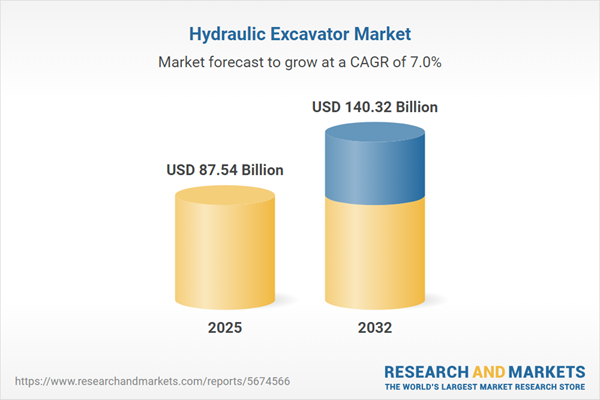Speak directly to the analyst to clarify any post sales queries you may have.
The hydraulic excavator market is undergoing a significant evolution as digital transformation and regulatory shifts redefine procurement and asset management priorities within heavy industries. Senior decision-makers must proactively navigate operational adjustments and compliance changes to maintain agility and strengthen organizational resilience.
Market Snapshot: Hydraulic Excavator Market Outlook 2024–2032
Between 2024 and 2032, the hydraulic excavator market is set for steady growth, supported by sustained investment in infrastructure, mining, and construction. Enterprises across these sectors are rapidly integrating digital platforms to optimize asset management and procurement workflows. At the same time, shifts in environmental regulation are elevating compliance expectations and prompting companies to rethink operational strategies. Adjustments such as digitized workflows and agile planning are enabling stakeholders to maximise efficiency, adapt to rising standards, and control risk amid dynamic conditions.
Scope & Segmentation: Hydraulic Excavator Market
This research delivers actionable insights for executives aiming to refine procurement, direct investments, and advance operational strategies against a constantly changing regulatory backdrop. Clear segmentation enables targeted asset optimization, ensuring alignment with diverse stakeholder needs and compliance mandates across global regions.
- Equipment Types: Crawler excavators offer durability and stability for demanding environments; wheeled models deliver mobility for projects needing frequent repositioning.
- Engine Power Bands: Diverse engine outputs allow managers to match machine strength to varying jobsite demands, covering both compact operations and major projects.
- End Users: Fields like construction, mining, infrastructure, and demolition depend on machines engineered for safety, reliability, and lifespan to realize operational efficiencies.
- Applications: Tasks such as trenching, material handling, demolition, and excavation benefit from advanced attachments that broaden utility and enhance site productivity.
- Sales Channels: Sourcing can be tailored through dealer networks, direct manufacturer relationships, or digital procurement platforms, supporting flexible acquisition strategies.
- Operating Weights: Machines classified under 10 tons, 10–20 tons, and above 20 tons enable leaders to fulfill project requirements and adapt to regional compliance.
- Technology Types: Diesel, electric, and hybrid systems address emissions goals and support adherence to advancing sustainability standards and regulations.
- Regional Coverage: Markets exhibit distinct behaviors across the Americas, Europe, Middle East and Africa, and Asia-Pacific due to local regulatory drivers and adoption patterns.
- Leading Companies: Sector innovation and product development are influenced by prominent manufacturers including Caterpillar, Komatsu, Hitachi Construction Machinery, Volvo Construction Equipment, SANY, Hyundai, Kobelco, J.C. Bamford Excavators, Doosan Infracore, and Liebherr.
Key Takeaways for Senior Decision-Makers
- Implementing digital controls and automation enhances operational reliability and project scheduling, minimizing downtime in complex hydraulic excavator deployments.
- Choosing electric and hybrid excavators supports sustainability initiatives while facilitating compliance with strengthening emissions standards worldwide.
- Adopting advanced emission and noise reduction technologies protects workforce health and reduces the risk of regulatory non-compliance and related costs.
- Diversifying supplier networks and investing in local sourcing strategies bolster equipment accessibility and improve resilience against market or regulatory disruptions.
- Ongoing improvements in battery technology and system integration reduce maintenance intervals, supporting long-term asset value and operational continuity.
- Regular updates to safety systems maintain alignment with evolving regulations, bolstering on-site safety and productivity across complex project requirements.
Tariff Impact: U.S. Hydraulic Excavator Market
Recent U.S. tariffs on hydraulic excavator components have led to increased import-related costs. This has accelerated domestic assembly operations and fostered deeper relationships with U.S.-based suppliers. Such shifts are strengthening supply chain reliability, enhancing asset endurance, and amplifying responsiveness to new policy and economic shifts.
Methodology & Data Sources
This research combines direct engagement with leading manufacturers, input from end users, and insights from market advisors. All findings are validated through regulatory review and focused secondary analysis to provide reliable intelligence for hydraulic excavator market stakeholders.
Why This Report Matters: Hydraulic Excavator Market
- Supports seamless digital transformation and the development of resilient compliance strategies amid evolving sector needs and regulations.
- Enables leadership teams to recalibrate procurement, increasing operational flexibility while reducing risk exposure.
- Delivers up-to-date regulatory and market insights, revealing actionable opportunities and refining risk management approaches in a changing industry environment.
Conclusion
Ensuring agile procurement, technology adoption, and regulatory foresight is fundamental for continued competitiveness in the hydraulic excavator sector. Executive focus on adaptability and proactive regulatory strategies underpins enduring growth and operational strength.
Additional Product Information:
- Purchase of this report includes 1 year online access with quarterly updates.
- This report can be updated on request. Please contact our Customer Experience team using the Ask a Question widget on our website.
Table of Contents
3. Executive Summary
4. Market Overview
7. Cumulative Impact of Artificial Intelligence 2025
Companies Mentioned
The companies profiled in this Hydraulic Excavator market report include:- Caterpillar Inc.
- Komatsu Ltd.
- Hitachi Construction Machinery Co., Ltd.
- Volvo Construction Equipment AB
- SANY Heavy Industry Co., Ltd.
- Hyundai Construction Equipment Co., Ltd.
- Kobelco Construction Machinery Co., Ltd.
- J.C. Bamford Excavators Limited
- Doosan Infracore Co., Ltd.
- Liebherr-International AG
Table Information
| Report Attribute | Details |
|---|---|
| No. of Pages | 199 |
| Published | November 2025 |
| Forecast Period | 2025 - 2032 |
| Estimated Market Value ( USD | $ 87.54 Billion |
| Forecasted Market Value ( USD | $ 140.32 Billion |
| Compound Annual Growth Rate | 6.9% |
| Regions Covered | Global |
| No. of Companies Mentioned | 11 |









